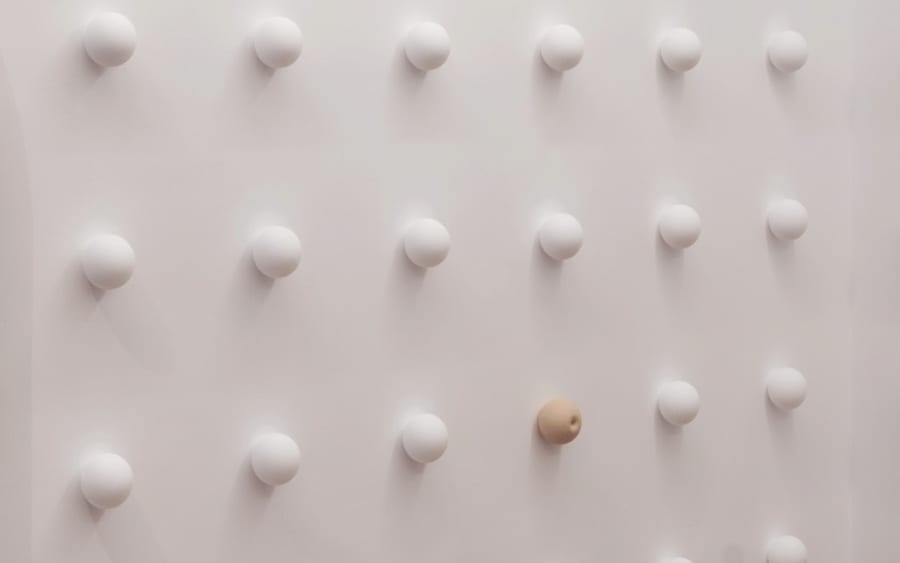Isaac Julien at Nara Roesler
Galleries, booth H15
The fact that the Harlem Renaissance – an explosion of Black creativity that began in 1920s New York – continues to inspire artists today is testament to its great significance. In 1989, British artist Isaac Julien gained recognition with his film Looking for Langston, an exploration of Harlem Renaissance-era writer Langston Hughes. Julien returned to the period’s themes with another film, Once Again… (Statues Never Die) (2022), examining the relationship between Alain Locke, a central figure in the movement, and a wealthy collector. Featured in the 2024 Whitney Biennial, a photograph from the connected series was recently acquired by Miami’s Pérez Art Museum, with another on view at Nara Roesler’s booth.
Geoffrey Holder at James Fuentes
Galleries, booth F18
To some, Geoffrey Holder’s résumé might sound like a starry-eyed dreamer rattling off a list of ideal jobs: principal dancer with the Metropolitan Opera Ballet, Tony-winning costume designer, celebrated painter, Bond villain, and 7UP soda pitchman. But Holder truly did it all. Born in Trinidad in 1930, he moved to New York, where he led a vibrant life of polymathic creativity. In 2024, a decade after his death, Victoria Miro hosted a joint exhibition in London of works by Holder and his equally accomplished older brother, Boscoe. Both created vivid portraits of Black people, rich with cultural pride and exuberance. In Miami, James Fuentes will showcase previously unseen works from Geoffrey Holder’s illustrious career.
Rosemarie Trockel at Sprüth Magers
Galleries, booth D14
In 1999, Rosemarie Trockel knew she’d have critics tied in knots when, as the first woman to represent Germany at the Venice Biennale, she exhibited knitted works. Why was a craft traditionally associated with women being shown at such a prestigious event? That provocation was precisely her point. Trockel had been creating machine-knitted wool works since the 1980s, challenging traditional notions of serious art by using a medium identified with domestic labor. The artist has since then widely expanded her practice, which now spans ceramics, photography, installation, and collage. Irrespective of the chosen medium, Trockel’s works always encapsulate her enduring areas of interest, including femininity, authorship, and the politics of artistic labor.
Shirley Jaffe at Nathalie Obadia
Galleries, booth C6
Mid-century Modernist painting had a tendency toward machismo and rigidity. It could all be so serious, so stiff, and American artist Shirley Jaffe wasn’t having it. She brought a sense of playfulness into abstract paintings, infusing her expressive works with loose, lyrical spontaneity. Even after a revelatory 1996 residency in Berlin that spurned a new, more graphic style, Jaffe never lost her sense of play. The geometric shapes – flat, bold, and capriciously arranged –seem to dance across the canvas. Jaffe lived in France until her death in 2016, and a major traveling solo exhibition toured between Paris, Basel, and Nice in 2022–23.
Gerhard Richter at Ben Brown Fine Arts
Galleries, booth H2
By the 1990s, Gerhard Richter had been grappling with painting for three decades. How could figuration and abstraction coexist? What role did photography play in the politics of representation? These questions demanded focus, so in 1991, Richter stepped back from the gallery circuit to devote himself fully to his abstract paintings. Using his now-iconic squeegee technique, he layered and scraped paint across the canvas, creating a dynamic interplay of control and chance. Works from this period – like the untitled oil-on-wood painting on view at Ben Brown’s booth – use muted hues to evoke both restraint and depth.
George Tooker at DC Moore Gallery
Galleries, booth E3
George Tooker knew what it felt like to be alone in a crowd. The late American artist’s meticulously rendered realist paintings portray familiar spaces – subway stations, office cubicles, waiting rooms – as haunted, airless purgatories. In these scenes, crowds of figures with blank, unreadable expressions seem unaware of one another – physically present yet emotionally adrift. Tooker’s use of egg tempera – a centuries-old medium that combines pigment with egg yolk – lent his paintings a glossy, luminous quality, intensifying the sense of being trapped in a fever dream. Beneath the critique of modern alienation lies a tenderness and empathy for the lost and the lonely.
Lygia Clark at Alison Jacques
Galleries, booth F8
For Lygia Clark, art was never just something to be looked at. The Brazilian artist believed that interaction – touching, manipulating, and even wearing materials – was as integral to art as the object itself. Begun in the 1960s, her Bichos (Critters), were hinged metal sculptures designed to be handled and transformed by the viewer, blurring the boundary between creator and participant. In the 1970s, Clark pushed this idea even further, abandoning traditional mediums entirely to explore art as therapy. Folding paper, breathing exercises, and sensory objects became tools for self-discovery and healing.
Art Basel Miami Beach will take place from December 6 to 8, 2024. Learn more here.
Elliat Albrecht is a writer and editor based in Canada. She holds a BFA in Critical and Cultural Practices from Emily Carr University of Art + Design and an MA in Literary and Cultural Studies from the University of Hong Kong.
Top image: Geoffrey Holder, Bathers (detail), 1979.
Published on November 29, 2024.


